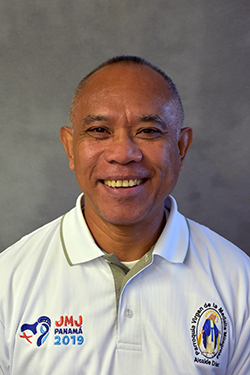By Theresa Carson
“If you build it, they will come” seems to be the motto of Father Lukas Batmomolin SVD, pastor of Sint Eustatius parish on the Caribbean island of the same name.
Not only are people returning to the physical building, but they are also partaking in building community.
Father Batmomolin arrived in St. Eustatius, a Dutch special municipality about 250 miles east of Puerto Rico, in October 2021. The eight-square mile island is home to about 3,000 inhabitants.
He is the only priest on St. Eustatius and one of 40 priests in the Catholic Diocese of Willemstad. Built in 1910, the church had not been renovated for more than a century.
Before he arrived, the island had been without a full-time Catholic priest for two years, so his first goal was to earn the people’s trust.
He was told that the church was ready to be renovated and that parish and diocesan committees would take care of the renovation. So, Father Batmomolin decided to focus his attention on repairing the oldest school building on the island for religious and educational purposes.
High atop a hill, the church is another one of the island’s oldest buildings. Twenty years ago, the cement walls had begun to crumble, so the pastor at the time placed plywood over it as a temporary fix.
During the renovation process, they realized that the buildings suffered from termites and the electrical system was badly in need of repair.
The unforeseen problems were revealed inside the walls once the plywood was removed, resulting in an unexpected rise in the cost by about $80,000.

The renovation work stalled for three months since the committees did not know how to get the needed funding. In January 2023, the parish renovation committee approached Father Batmomolin for help. He agreed to assist on the condition that the cost for the remaining work be cut in half.
St. Eustatius, also known as Statia, has a storied history. Initially colonized by the English and French in 1625, the island became a Dutch territory in 1632.
“The island bloomed in the 1700s,” said Father Batmomolin, who was born and raised in Indonesia, another country that played a prominent role in Dutch trade.
Under Dutch control, the island developed into a center of commerce and an important and controversial hub for the Dutch West India Company.
Statia’s prominent place in international economics made it a center point of slavery. Slave traders shipped countless captives from Africa to St. Eustatius, where they were then dispersed to plantations far and wide.
At its height, the Statian population burgeoned to 20,000. In 1847, enslaved people in St. Eustatius revolted, and slavery was abolished by law in 1863.
The island also became a center of goods from Dutch merchants who supported the American Revolution. In fact, Dutch West India Company cannons fired the first international salute to the flag of the newly formed United States on Nov. 16, 1776.
However, the Atlantic Ocean’s deadliest hurricane devastated the island in October of 1780, killing an estimated 4,500 people and leveling buildings and trees. And four months later, the British invaded, effectively ending the island’s glory days.
Today, most locals are employed by the Dutch government. Like many places with smallish populations, the young people typically leave the island to look for work elsewhere.
Some jobs can be found in the island’s oil terminal and small businesses in addition to tourism. A small number of tourists visit the island to explore its rich history.
Although rainfall is sparse, they grow onions, yams, and sweet potatoes, and lobsters and fish are caught for local consumption.
“What I like about the island is that it has almost zero crime,” Father Batmomolin said. “Very peaceful.”
Both the Catholic church and school buildings are Statian historical monuments, so Father Batmomolin made the church renovation project a priority and looked for donations from benefactors, including from the Society of the Divine Word Chicago Province, Mission Office and Divine Word Residence.
“I knew I could animate the community for painting and cleaning,” Father Batmomolin said.
Divine Word pastors on the islands of Saba and St. Maarten also rallied their parishioners.
“People contributed whatever they could, especially time and energy,” Father Batmomolin said. “They gave resources and energy to fixing the church because they see benefits for the future of the community. With many people and with God, something can be accomplished.”
On Dec. 3, the parish celebrated rededication of the renovated church and a Mass of Thanksgiving with Most Rev. Luis Secco SDB, bishop of the Diocese of Willemstad, as the main celebrant.
Now that the church renovation is almost complete, Father Batmomolin plans to continue to repair the oldest school building on the island and use the school as a pastoral center that will provide space for youth activities, religious education, Confirmation and First Communion classes.
The repairs will continue in accordance with available funding, he said. They have eradicated the termites, fixed the electrical system and replaced the rotting wood floor. The remaining work now consists of replacing the wood floor, doors and windows.
“The parish will not be able to afford the repairs, so we have to look for more financial help from outside,” Father Batmomolin said.
However, the people on St. Eustasius are noticing the changes.
“They are coming back to church to baptize their children,” Father Batmomolin said. “Last year, one student celebrated the Sacrament of First Communion; this year, we had 12. I appreciate the resiliency of the people here. I said, ‘Pray with me. God will show us the way,’ and He did.”